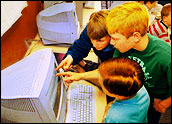
At last week’s Aging in America conference in Washington, attendees were greeted with multiple displays of technology aiming to help older people live better. A technological divide exists between the “oldest old” and the “recently old” baby boomers, but technologies developed for both groups may also be able to help younger generations fight aging.
“I don’t think it’s fair to think that boomers are like their parents,” said Adriane Berg, author of How Not To Go Broke at 102, due for re-release in July. “Change is what we know.”
It’s certainly true that boomers are repainting the aging landscape, and making use of technology is big on their agenda. Joining social networking sites like Boomj and Rezoom, Berg has launched her own Web site, WealthBuilder Longevity Club, that aims to use technology to network boomers for travel, old-fashioned key exchanges, and even real estate cohousing arrangements. While social networking is a tech trend flowing from younger to older circles, a reverse flow is set to happen in other areas.
Cognitive Exercises
Cognitive decline, for instance, is a big issue as individuals get older, but decline doesn’t start suddenly when one becomes a senior. It happens slowly over time and can even occur because of certain events, such as chemotherapy treatment. Many companies have produced software to fight mental decline, and one of the most impressive is CogniFit.
For US$139, Cognifit’s MindFit program exercises 14 different mental skills and works on an individualized basis so that it gets more difficult as the user gets better. Exercising one’s brain not only helps with memory and attention deficit issues, but also helps reduce depression and stress. The company is currently producing a program for the younger workplace set, making it clear that everyone benefits from cognitive exercises.
Of course, some of America’s oldest don’t use computers and, indeed, the conference didn’t even offer Internet access to its 4,000 attendees, save 10 terminals in a makeshift cybercafe. Only 28 percent of Americans age 70 and older go online, according to the Pew Internet & American Life Project. This is sometimes known as the “grey divide,” and for those who fall into this camp, devices like Dakim’s [m]Power offer cognitive training programs using a touch screen instead of a mouse and keyboard. However, even if a person isn’t using cognitive training software, it may be possible to detect cognitive impairment simply by measuring a person’s gait.
“We can catch the early onset of multiple sclerosis, Huntington’s or Parkinson’s by noticing subtle changes in a person’s gait,” said Michael Rowling of Gaitrite, a company that makes a portable walkway that digitally captures people’s steps. The product can also help diagnose running injuries and is now being used by the U.S. Army to measure improvement in wounded soldiers. I tried the product and my gait analysis can be found here.
Driving Innovation
One can easily see how technologies aimed at helping elder communities can be used in a positive way by younger people. Home Guardian, a company that makes sensors to monitor non-intrusively the health status of elders, is another example.
By simply placing a thin plastic mat with sensors under an individual’s bed, the folks at Home Guardian can monitor the sleeper’s heart rate and breathing. It’s possible to do it this way because one’s breathing and heart rates have different frequencies. For individuals with a potentially serious disorder like sleep apnea, this could be a fast and easy way to diagnose the problem. For elders, it could mean the difference between life and death.
The longevity revolution is just beginning. Older elders and the boomer generation may have much different ideas about what retirement should look like, but the needs of both communities is driving innovation in tech that will wind up helping everyone, including those in generations X and Y.
Sonia Arrison, a TechNewsWorld columnist, is senior fellow in technology studies at the California-based Pacific Research Institute.




















































